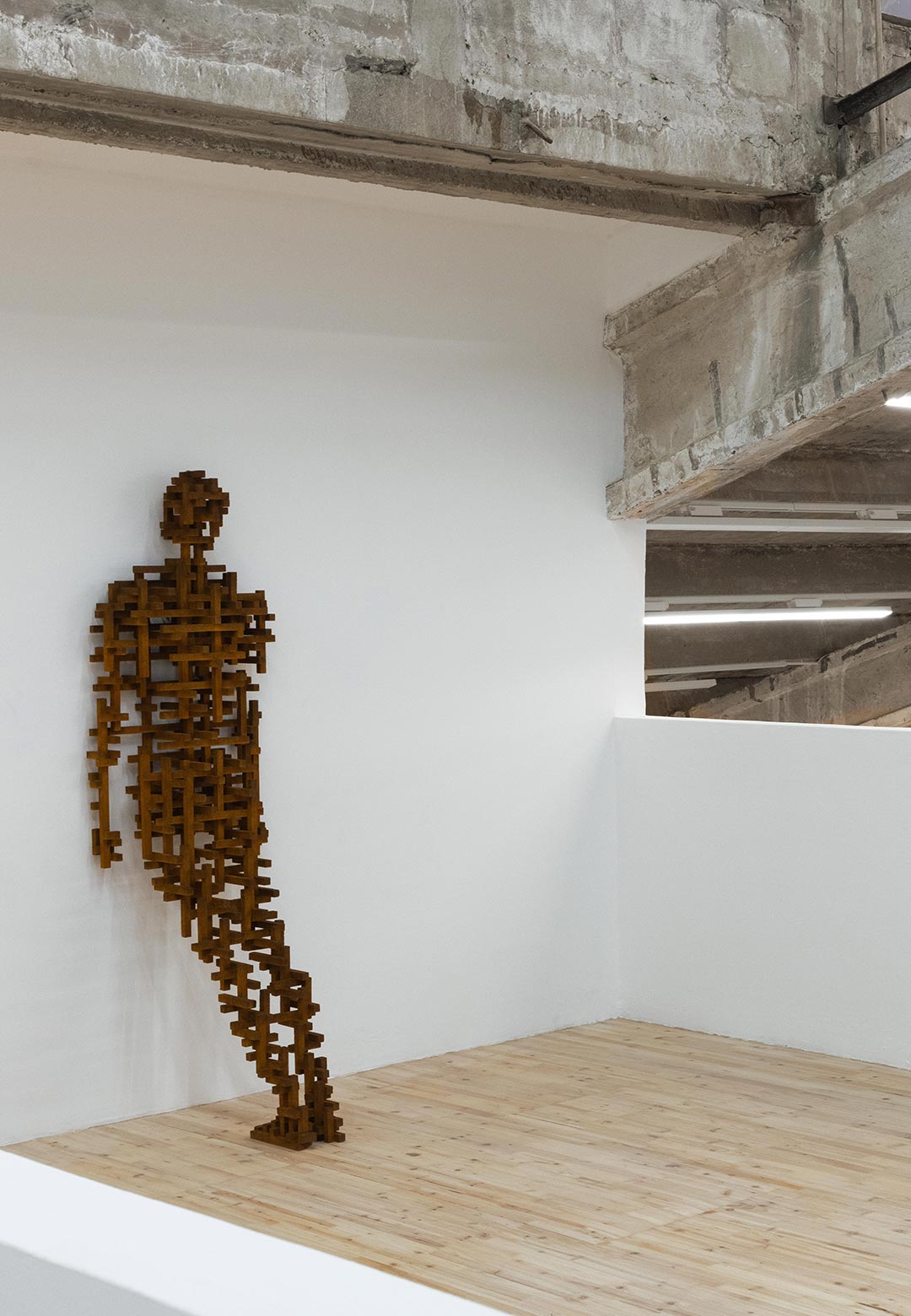Known for his sculptures, installations and public artworks investigating the relationship between the human body and space, Sir Antony Mark David Gormley OBE RA presents Body Buildings at Galleria Continua, his third solo exhibition at the 798 Art District in Beijing, China, following Another Singularity (2009) and Host (2016). The art exhibition on view from November 14, 2024 - April 14, 2025, "interrogates our species' relationship to the built environment, an increasingly high-rise world we rarely escape," according to the contemporary art gallery, through a significant batch of recent sculpture art and drawings. For the ongoing show, Antony Gormley employs clay and iron, "two ubiquitous materials of the built world, 'to think and feel the body in this condition'," the show's description relays.
The show's centrepiece, Resting Place II, conjures a labyrinthine terrain for viewers to enter and navigate. This field of 132 life-sized bodies, formed from stacked fired clay bricks, examines the resting body as a primary dwelling place. For the British sculptor, the brick is a 'physical pixel' deeply rooted in Chinese culture. Arranged in various orthogonal yet precarious positions, the bodies evoke states ranging from relaxed sprawl to fetal self-protection. Viewed from the art gallery's first and second-floor balconies, the interaction between moving visitors and horizontal clay forms creates a dynamic space shaped by individual experience.
"Resting Place II evokes the human body's relationship to the ground, the surface of the earth. It refers to two very different kinds of abandonment: the relaxed abandonment of the body on the beach, the place to which we return in childhood play and relaxation and another, that of the migrant who has either forcibly or freely sought a new home. What at first looks like a chaotic display of building materials might resolve into the model of a city and further resolve into the invitation to empathise with the body as a place of indwelling, some evoking states of deep relaxation and contentment, others of retreat and defence," as Gormley puts it.
Accompanying Resting Place II are sculptural art pieces cast in iron such as Circuit and Ally, which draw parallels between urban infrastructure—roads, electrical circuits, plumbing—and human relationships. Circuit reimagines these systems as a circulatory network connecting two bodies, while Ally uses stacked cast iron blocks to explore how two bodies achieve mutual stability through a shared centre of gravity. These works by the London-born contemporary artist examine how urban environments shape and reflect human connections.
Flanking Circuit is Short and Shame, which treats the body as an energy field, "in which the body veers from its centre of gravity, purposefully avoiding the stability associated with statues of power," the show's description notes. Shame, with its tight knots, identifies tension points—ankles, knees, pelvis, head and hands. In contrast, Short transcends the physical boundaries of the skin, as its iron lines extend beyond the body's surface.
On the gallery's top floor, Rule III and Buttress turn bodily space into a latticed scaffold, reminiscent of the skeletons of contemporary high-rise architecture. "In doing so, the works materialise the way that having made a world, it now makes us," as Continua conveys. The two rusted sculptures, positioned against the walls, connect directly to the architectural space, prompting visitors to reflect on their relationship with the built environment.
Accompanying the sculptures are several drawings: Singularity X and Event VII suggest the luminous emergence of astral matter. These are paired with layered Lux drawings, which evoke apertures or light sources glimpsed from within interiors. Other pieces, created with inkcap mushroom ink, carbon and casein, examine darkness as both an inner and relational experience.
"Body Buildings is an interrogation of the state of our species. Gormley offers these sculptures as diagnostic tools to examine our present condition," the press release states.
"His work has developed the potential opened up by sculpture since the 1960s through a critical engagement with both his own body and those of others, confronting fundamental questions about where human beings stand in relation to nature and the cosmos. Gormley continually seeks to identify the space of art as a place of becoming, where new behaviours, thoughts and feelings can arise," they continue.
The sculpture artist has received numerous accolades, including the Turner Prize (1994), the South Bank Prize for Visual Art (1999), the Obayashi Prize (2012) and the Praemium Imperiale (2013). He was made an Officer of the British Empire (OBE) in 1997 and knighted in 2014. He is an Honorary Fellow of the Royal Institute of British Architects, an Honorary Doctor of the University of Cambridge, and a Fellow of both Trinity and Jesus Colleges, Cambridge. Gormley has been a Royal Academician since 2003.
His work has been extensively exhibited both in the UK and internationally, with recent shows at the Musée Rodin, Paris (2023); TAG Art Museum, Qingdao (2023); Museum Voorlinden, Wassenaar (2022); National Gallery Singapore (2021); Royal Academy of Arts, London (2019); Delos, Greece (2019); Philadelphia Museum of Art, USA (2019); Long Museum, Shanghai (2017), and more. His permanent public works include Angel of the North (Gateshead, UK), Another Place (Crosby Beach, UK), Inside Australia (Lake Ballard, Western Australia), Exposure (Lelystad, The Netherlands, Chord (MIT, Cambridge, USA), and Alert (Imperial College London, UK).






 Sign in with email
Sign in with email










What do you think?